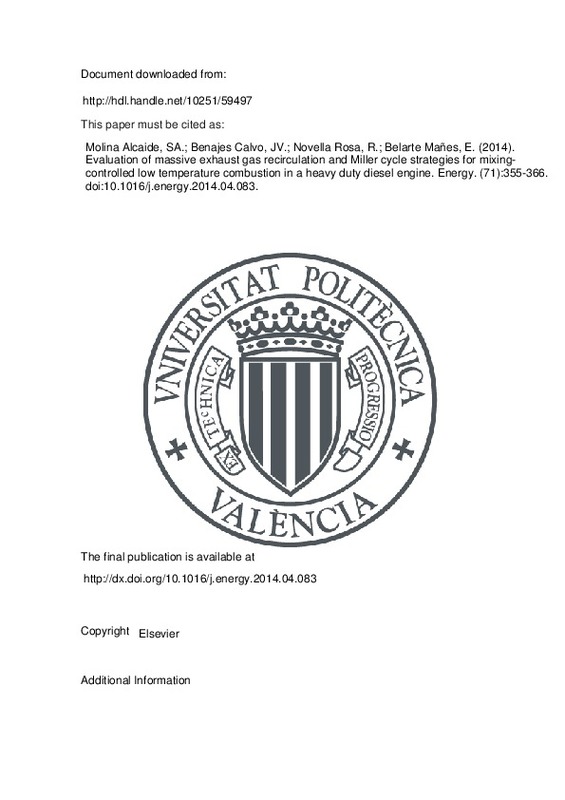JavaScript is disabled for your browser. Some features of this site may not work without it.
Buscar en RiuNet
Listar
Mi cuenta
Estadísticas
Ayuda RiuNet
Admin. UPV
Evaluation of massive exhaust gas recirculation and Miller cycle strategies for mixing-controlled low temperature combustion in a heavy duty diesel engine
Mostrar el registro sencillo del ítem
Ficheros en el ítem
| dc.contributor.author | Benajes Calvo, Jesus Vicente
|
es_ES |
| dc.contributor.author | Molina Alcaide, Santiago Alberto
|
es_ES |
| dc.contributor.author | Novella Rosa, Ricardo
|
es_ES |
| dc.contributor.author | Belarte Mañes, Eduardo
|
es_ES |
| dc.date.accessioned | 2016-01-07T11:33:06Z | |
| dc.date.available | 2016-01-07T11:33:06Z | |
| dc.date.issued | 2014 | |
| dc.identifier.issn | 0360-5442 | |
| dc.identifier.uri | http://hdl.handle.net/10251/59497 | |
| dc.description.abstract | The future of compression ignition engines depends on their ability for keeping their competitiveness in terms of fuel consumption compared to spark-ignition engines. In this competitive framework, the Low Temperature Combustion (LTC) concept is a promising alternative to decrease NOx and soot emissions. Thus, this research focuses on implementing the LTC concept, but keeping the conventional mixing-controlled combustion process to overcome the well-known drawbacks of the highly-premixed combustion concepts, including load limitations and lack of combustion control. Two strategies for implementing the mixing-controlled LTC concept were evaluated. The first strategy relies on decreasing the intake oxygen concentration introducing high rates of cooled EGR. The second strategy consists of decreasing the compression temperature by advancing the intake valves closing angle to reduce the effective compression ratio, compensating the air mass losses by increasing boost pressure (Miller cycle). These strategies were tested in a single-cylinder heavy-duty research engine. Additionally, 3D-CFD modeling was used to give insight into local in-cylinder conditions during the injection-combustion process. Results confirm the suitability of both strategies for reducing NOx and soot emissions, while their main drawback is the increment in fuel consumption. However, they present intrinsic differences in terms of local equivalence ratios and temperatures along combustion. | es_ES |
| dc.description.sponsorship | The authors of this paper thank the Spanish Ministry of Economic and Competitively for the financial support of this research through the project TRA2010-20271 (LOWTECOM). | en_EN |
| dc.language | Inglés | es_ES |
| dc.publisher | Elsevier | es_ES |
| dc.relation.ispartof | Energy | es_ES |
| dc.rights | Reserva de todos los derechos | es_ES |
| dc.subject | Compression ignition engines | es_ES |
| dc.subject | Emissions control | es_ES |
| dc.subject | Engine efficiency | es_ES |
| dc.subject | Low temperature combustion | es_ES |
| dc.subject | Miller cycle | es_ES |
| dc.subject.classification | MAQUINAS Y MOTORES TERMICOS | es_ES |
| dc.title | Evaluation of massive exhaust gas recirculation and Miller cycle strategies for mixing-controlled low temperature combustion in a heavy duty diesel engine | es_ES |
| dc.type | Artículo | es_ES |
| dc.identifier.doi | 10.1016/j.energy.2014.04.083 | |
| dc.relation.projectID | info:eu-repo/grantAgreement/MICINN//TRA2010-20271/ES/COMBUSTION A BAJA TEMPERATURA EN MOTORES DIESEL PARA REDUCIR SIMULTANEAMENTE LAS EMISIONES DE NOX Y HUMOS/ | es_ES |
| dc.rights.accessRights | Abierto | es_ES |
| dc.contributor.affiliation | Universitat Politècnica de València. Departamento de Máquinas y Motores Térmicos - Departament de Màquines i Motors Tèrmics | es_ES |
| dc.description.bibliographicCitation | Benajes Calvo, JV.; Molina Alcaide, SA.; Novella Rosa, R.; Belarte Mañes, E. (2014). Evaluation of massive exhaust gas recirculation and Miller cycle strategies for mixing-controlled low temperature combustion in a heavy duty diesel engine. Energy. (71):355-366. https://doi.org/10.1016/j.energy.2014.04.083 | es_ES |
| dc.description.accrualMethod | S | es_ES |
| dc.relation.publisherversion | http://dx.doi.org/10.1016/j.energy.2014.04.083 | es_ES |
| dc.description.upvformatpinicio | 355 | es_ES |
| dc.description.upvformatpfin | 366 | es_ES |
| dc.type.version | info:eu-repo/semantics/publishedVersion | es_ES |
| dc.description.issue | 71 | es_ES |
| dc.relation.senia | 284683 | es_ES |
| dc.contributor.funder | Ministerio de Ciencia e Innovación | es_ES |







![[Cerrado]](/themes/UPV/images/candado.png)

